15 June 2011
Obsidian hunting in the Jemez Mountains
Posted by Jessica Ball
This past weekend I took a day to go revisit the Valles Caldera. While I was wandering the trails, I decided to do a little “rockhounding”. Geologists are often notorious for their rock collections, and I felt like mine was missing something that no volcanologist should be without: Obsidian.
Obsidian is basically volcanic glass – the result of lava cooling so quickly that it doesn’t have time to develop crystals. Pure glass is basically SiO2 (or silicon dioxide), and obsidian tends to form from rhyolitic magmas (which already have a high percentage of SiO2, typically greater than 68%). “Heavy” minerals in the obsidian (such as those containing iron and magnesium) make the glass dark, and (depending on their oxidation state) can give it reddish or greenish hues.
Because obsidian has no crystal structure, it breaks like glass, with what’s called conchoidal fracture. This produces curved rather than straight surfaces, and is one of the reasons that obsidian was (and still is) desirable as a tool. Ancient cultures chipped obsidian into extremely sharp cutting tools and weapon points, and obsidian scalpels – which have much sharper edges than steel ones – are used today in delicate surgeries, including eye surgery.
Obsidian is pretty common in the Jemez Mountains, particularly in the Banco Bonito rhyolite. Once you leave the Valles Caldera (a National Preserve), you’re in the Santa Fe National Forest; casual rock collecting is allowed, as long as you’re not carting off massive amounts of material (no more than a bucket per day). The best place to find bits you can legally collect is in the East Fork of the Jemez River, which you can get to using the Las Conchas trail.
Like sea glass, obsidian that ends up in a riverbed gets worn down (as if it was in a rock tumbler), so your best bet is to look for dark pebbles and cobbles that have chips out of them – this is where obsidian’s conchoidal fracture helps you out. The chunks are usually very rough and won’t be translucent at first sight, but you can crack them open to reveal the glassy interior.
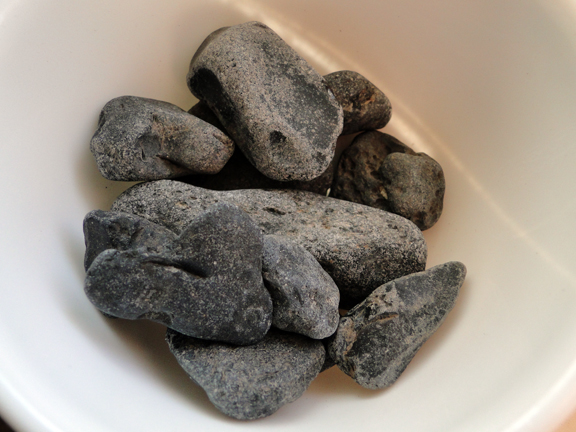
"Tumbled" obsidian, straight from the riverbed. Some pieces have been chipped and reveal the tell-tale conchoidal fracture.
As an archaeology minor as well as an avid collector, I find obsidian fascinating for its historical as well as volcanic significance. And it’s pretty! (A word of warning, however: If you’re going to break your obsidian pieces, be really careful and wear eye protection – this stuff is sharp, too!)


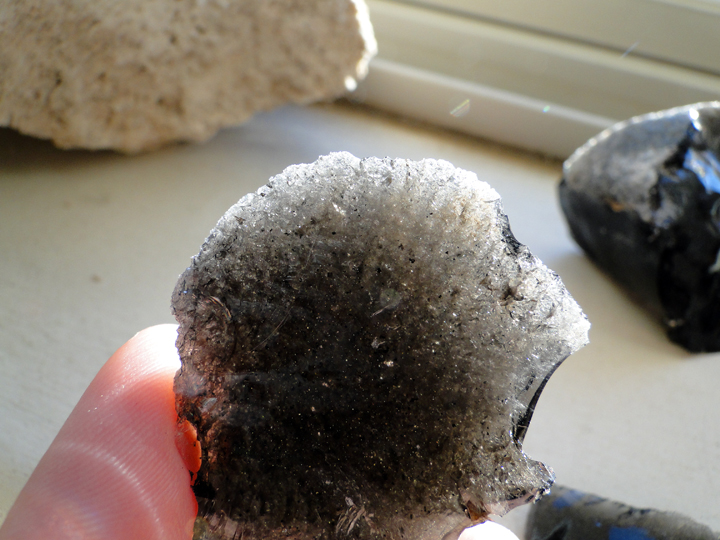
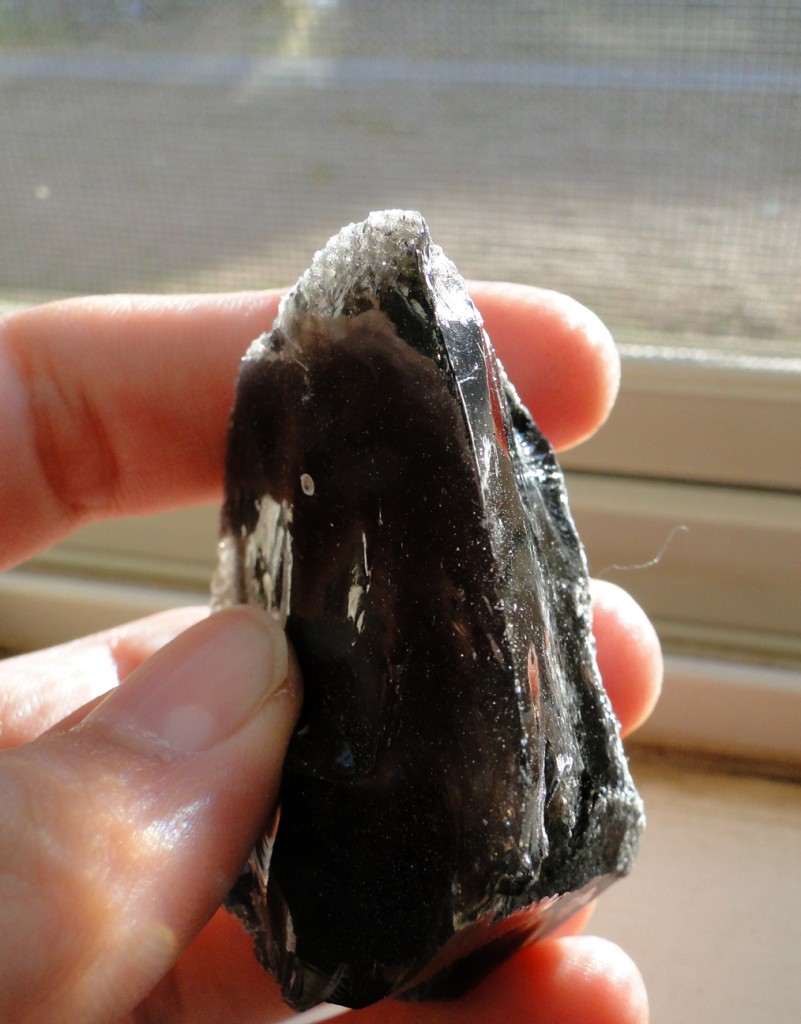
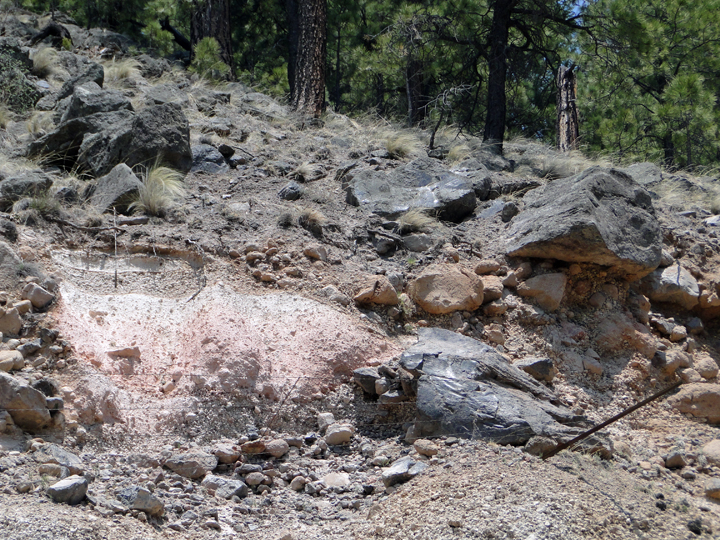
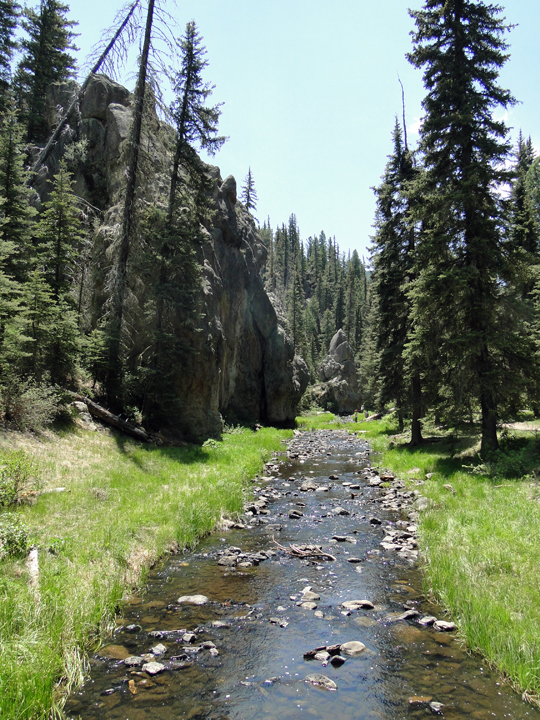
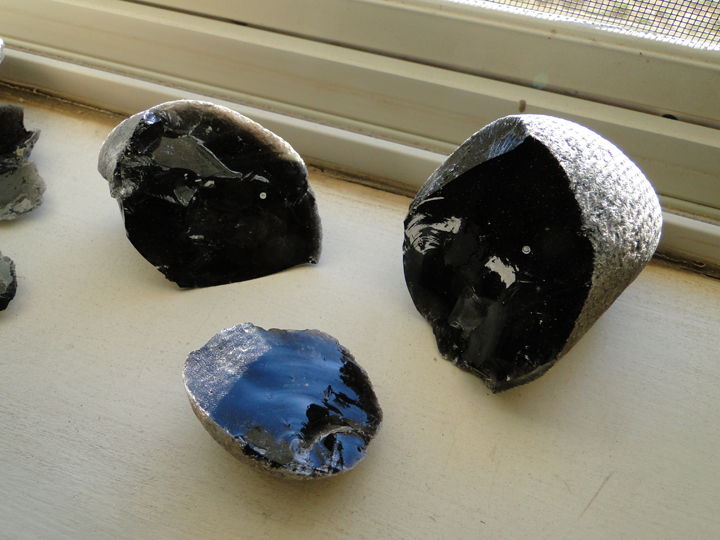
 Jessica Ball is a volcanologist at the U.S. Geological Survey, researching volcanic hydrothermal systems and stability, and doing science communication for the California Volcano Observatory. She previously worked at the Geological Society of America's Washington DC Policy Office, learning about the intersection of Earth science and legislative affairs. Her Mendenhall postdoc and PhD focused on how water affects the stability of volcanoes, and involved both field investigations and numerical modeling applications. Her blogging covers a range of topics, from her experiences in academic geosciences to science outreach and communication to her field and lab work in volcanology.
Jessica Ball is a volcanologist at the U.S. Geological Survey, researching volcanic hydrothermal systems and stability, and doing science communication for the California Volcano Observatory. She previously worked at the Geological Society of America's Washington DC Policy Office, learning about the intersection of Earth science and legislative affairs. Her Mendenhall postdoc and PhD focused on how water affects the stability of volcanoes, and involved both field investigations and numerical modeling applications. Her blogging covers a range of topics, from her experiences in academic geosciences to science outreach and communication to her field and lab work in volcanology.
Good geode collecting in the Jemez Mts too if I remember correctly…am I remembering correctly?
I’ll have to check! Geodes would definitely be fun to hunt for.
Funny. Here in Iceland we have a complete obsidian lava field – collecting pieces is pretty easy there. You have to be carefull not to collect too much stuff 🙂
Great stuff. Just to be clear is the dark color due to heavy minerals or elements? So is the iron some sort of hematite or just iron?
Whoops! Sorry for the confusion. The iron and magnesium are in the heavy minerals, so you have things like hematite (reddish) or magnetite (black) contributing to the color.
No worries. I’m a paleontologist so unless it’s an ash layer with fossils in it I don’t worry too much (like at all) about igneous petrology. But this does come up with my students: I do the whole dark color mafic / light color felsic thing then they come to the obsidian . . . oops. So it’s great to know what’s going on.
Are the ashfall volcanics still glass as well, or have they devitrified?
Good question! I seem to remember seeing devitrification zones mentioned in some of the papers I’ve read about the Bandelier Tuff, but I’d have to check.
From an old glass geologist: The black color of obsidian is due to iron dissolved in the glass, not generally as separate minerals. But individual mineral grains of ferromagnesian minerals do occur, depending on the cooling conditions.
Commercial glass is not pure silica. Usually about 70% SiO2, depending on the formulation and intended use, the rest being alkalies to lower the melting point, a little alumina for durability, and perhaps colorants. Pure silica glass is very difficult to make, because silica melts at a very high temperature, and is so viscous it cannot be worked. The high-silica glass once (perhaps still) marketed by Corning was made as a alkali silicate glass, from which the alkali was leached by acid. The resulting porous glass was densified by heating.
BTW, the xtallinity of volcanic ash probably depends to a large degree on its age, and on the soil conditions, including the exposure to water. Older falls may well have devitrified, but younger ones, such as the Pearlette of TX and OK, is still glassy at (I think) about 600,000 years. Makes a great fine abrasive
Thanks for the corrections! I’m not very familiar with obsidian, so I was going off the USGS website – apparently they could use a little updating as well.
I can vouch for the ash as an abrasive; the dust coming off the volcanic units here in Los Alamos is very gritty and gets into everything.
I love your web sight and the information you shared about finding obsidion I always wanted to find osbidion that is bigger than a marble which is what I have always found in Utah when I was still sighted.
I am 42 years old and I went blind from gloucoma. I decided that I wanted to go to college and study what I wanted to completely unabashed. But I found resistance from blind counclers and family because they could not see how I could posibly study some thing I could not see. But I did it anyway.
As soon as I got to college and started studying earth science the entire science department took me in and met the challenge of teaching me science.
I am finishing my second year this summer.I work with a tutor that can explain to me any graph or picture. I have just recently been using the inter net to learn new things about the planet I live in so scientist like your self blogging information on the internet is so important.The information you share about rock hunts and observation is the closest some of us will be able to get. So rock on, Mike Lott
Mike,
I’m so glad to hear that you find my blog helpful! I couldn’t imagine what it would be like to try and do geology without the benefit of sight, but it’s great to know that you’ve taken on the challenge. So much of science is about description – and making that description understandable to everyone – and adapting geology for a skill set like yours sounds like a fascinating task. Keep up your studies and keep sharing your interest!
Brings back memories from 25+ years ago. While I was at UTEP, we did a field trip that included the Valles Caldera, but didn’t take the time to collect obsidian (or else the prof didn’t know where to find the obsidian). I wish I had gotten a few more photos.
I am not a geologist at all but have always been fascinated by obsidian…I have a house on the shores of Lake Taupo, central North Island of New Zealand, a massive volcano of course. Our beach is rich with obsidian cobbles…all of which have the same dark grey speckled colour and unlike your riverbed samples are very smooth. As children we learnt to recognize the exterior colour and how to safely “smash” them to reveal the jet black “glass” beneath. I have a single piece under the house that weighs 10kg…
I could post you some next summer if you would like…
What a place to live! That sounds like a perfect beach for a volcanologist – and anyone who likes to smash rocks 🙂 If it’s not too expensive for you, I would love to have a bit of Taupo obsidian. Thank you for the offer!
Thank you for this. my wife has become certified in in hot stone massage( Awesone if you have a cahnce to get one.) This gives us an excuse to go rock hunting for her tools. We want to get some obsidian. This was really helpful. Best wishes to you in your future endeavours. my sister graduated for U of Buffalo. Good school.
Interesting information on obsidian with nice photos. I have lived in Albuquerque and been hunting rocks in the Jemez Mts for over 40 years. I have found some nice obsidian, some the look as if they had been chipped for stone tools instead of just weather and time worn. Wish I knew more places to find nice obsidian and other semi precious stones without having to hike for miles to get to the good areas. Have found a few almost geode but found better ones down in the Gila National Forest near Silver City, NM.
Thanks for this site. I live in southern Arizona now and miss the Jemez. I’m a writer and wanted to refresh my memory about obsidian.
Thank you so much for sharing this blog post! It was a huge help. My boyfriend and I wanted to collect some local minerals while in NM and this was the perfect adventure!
Hi Jessica! Great post and I have kept it bookmarked for years and finally got up to the Las Conchas Trail today. Sadly, I didn’t have any luck finding obsidian.
Do you happen to remember where you found your specimens? Were they in the river or outside of it? I’m open to going back tomorrow, but my eye is not really sure how to pick them out.
Thanks for the wonderful info and photos! If I have any luck, I will let you know.
Just got back and couldn’t find a thing sadly. Guess I need more practice. Also disappointed to see so much trash along the trail. In any event, the scenery was worth the visit.
Great info on Obsidian, thank you! I love Valles Caldera and while visiting years ago to fish the headwaters Rio San Antonio, before the park service took over. So I got that far into the Caldera after only seening it from Hwy 4 for many years. What a magnificent place another true wonder of the world. Isn’t there a Mountain, valley or canyon inside the Caldera called Obsidian. I asked two people I met coming the opposite way after fishing…and on a road inside the caldera, off the reservation fishing area…naturally they reported me….but you know how hard it was not to explore when you’re inside this 13 mile crater…anyway these snitches did confirm Obsidian Valley/Canyon/Mnt. but the map I picked up this Summer at the Caldera Store does not list it. Any info would be appreciated!
Hello,
Can I use one of the images projected on this page of Magma Cum Laude?
I just happen to scan the internet for obsidian articles and saw this page and pictures,
specifically the last picture, the interior of obsidian cobble. Where must this cobble stone came from?
Thanks. (on July 7, 2020, Metro Manila, Philippines)
I’ve been fishing in the Jemez for the past few months off and on, and am happy to have found your blog. I’m also a rockhound, and found a broken obsidian arrow point in my neighborhood in Santa Fe. I assume it is from Jemez but am wondering if it’s possible to find out where it was quarried. Imagine the project of mining it, carrying it over the Rio Grande, knapping it, attaching it to an arrow very carefully, and using it for hunting, only to have it break. The care and caring and hard work of these people, who did so much and left us so little evidence of the things they did and loved. Thanks for your site. ~Rich Binell